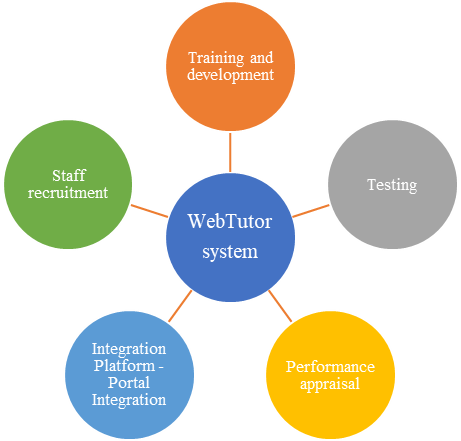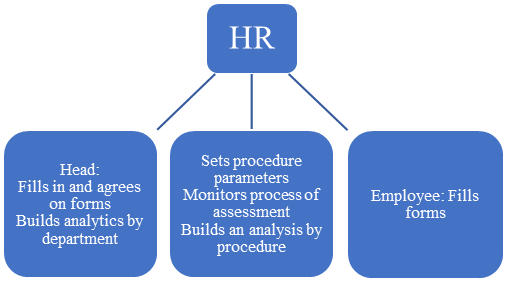Abstract
Improving the quality of personnel management at the present stage is one of the main components of an enterprises economic policy. One of the most important ways to solve this problem is correct IT-architecture and processes of communication services support. The real situation on the market requires an increase in the efficiency of an enterprise via a strict selection of new technologies. The task of information technology implementation in an enterprise is mostly to provide optimal information support IT-structure. Оne of the most valuable data sources is information from employee. In this way, it’s necessary to develop the system of employee’s surveys and obtain high quality information via strong rules inside the system. The main goal of creating and improving information and communication technologies system strategy is to provide information support between management and subordinate in order to achieve sustainable competitiveness and high efficiency. One of the most important areas is the labor efficiency of individual workers and the entire staff evaluation. The WebTutor business process automation system can be used for HR-processes organization. The personnel assessment module is a part of an integrated solution that allows to automate various forms of employee performance assessment, employee testing and employee’s surveys.
Keywords: Automationpersonnel assessmentinformation and communication technologiesdigital technologiespersonnel management
Introduction
Conditions for effective management decisions
In modern conjuncture, enterprises and corporations in Russia are faced with various problems. One of them is human resource management. The effective management decisions are necessary to ensure the competitiveness of enterprises in the labor market. The organizational essence of the management decision includes the personnel of an enterprise involvement.
The impact of employee labor on achieving an enterprise goals
Researches in Russia and abroad demonstrate that necessity to solve issues related to ensuring staff involvement. It is possible to assess the level of staff involvement through traditional surveys. The concept of staff performance is to regularly evaluate its performance. The employee’s labor affects result the achievement of an enterprise’s goal.
Problem Statement
Enterprise Management Requirements
Currently, business processes of creation and communication support in the enterprise play a major role in ensuring the company's competitiveness in the labor market. The real situation on the market requires certain demands for management. According them each enterprise has to follow a new technologies strict selection.
Statement of the problem of using information technology at the enterprise
In a market economy, the use of information technology in enterprises whose activities are directly related to the processing and analysis of “big data” is especially necessary. The fundamental task for information technology is to provide IT-architecture for information support system. The functional purpose of this system should correspond to the management and employees goals. Information support from HR point of view consists of system for employee’s surveys development, improvement and support. In most research, assessment of psychological (in) flexibility has been done with the Acceptance and Action Questionnaire yet researchers have noted that items on the AAQ may not adequately discriminate between responses to experiences and the experiences themselves (Ong, Pierce, Woods, Twohig, & Levin, 2018).
Research Questions
Successful activity of any organization is impossible without a comprehensive analysis of labor indicators. In a market economy, one of the most important areas of this analysis is a set of measures to evaluate the labor efficiency of individual workers and the entire staff as a whole, the main purpose of which is to increase the company efficiency.
Discussing an effectiveness of the personnel measuring, an automated assessment system helps in achievement of the most important tasks - to determine: in which area the employee works best; as a leader it is better to use it in order to avoid internal contention between employees in favor of the profitability and effectiveness of the enterprise. The system must help to link the strategic goals of an enterprise with the employee’s daily activities and allow employees to focus on tasks that clearly contribute to the target result achievement, transferring secondary tasks to the background. The system will dynamically change depending on an enterprise needs.
Purpose of the Study
Strategy for improving the system of information and communication technologies
The main goal of the strategy for information and communication technologies system creating and improving is to provide information support between management and subordinate in order to achieve sustainable competitiveness and an enterprise high efficiency.
Key modules of the WebTutor system
Without doubt the HR sphere transition to the Digital format is an unconditional trend. That is confirmed by leading researchers and analysts. This trend tells that for working with people (selection, training, development) we need to analyze a lot of different information. This will require a single digital environment in which all HR processes will be organized. Such an environment is WebTutor, a business process automation system. The personnel assessment module is part of an integrated solution. This module can be used as an element of the personnel assessment procedure and as an accompaniment to the training process (Schönebeck & Schoenebeck, 2015). In Figure

Source: authors.
Key functionalities for staff assessment
Personnel assessment is part of an integrated solution. The “Personnel Evaluation” module of the WebTutor system allows you to automate various forms of evaluating performance results, conduct testing and surveys of enterprise employees (Table
An example of an automated personnel assessment procedure is presented in Figure

Source: authors.
Automation capabilities of the personnel assessment module
Various assessment procedures can be automated:
Automation of personnel assessment is necessary for:
Reduced labor costs for entering and processing evaluation data;
Analysis of assessment results using reports;
Saving assessment data (Østergaard, Lundgren, Zettle, Landrø, & Haaland, 2020).
Research Methods
Form for employee’s survey
A survey based certain form of a table was conducted and it comes conclusion about the level of automation of an enterprise (Akhuly, Bhardwaj, & Shandilya, 2018) (Table
Advantages of automated assessment of enterprise personnel
Recent research in Hangzhou show a participatory innovation can lead to increased accountability and responsiveness of the local government (Almén, 2017).
Considering the procedure for conducting an automated assessment of enterprise personnel, we came to the conclusion that this procedure has several advantages:
Automated processing and results can guarantee user privacy and data security;
The development of an automated assessment system is carried out in accordance with the goals and objectives of the enterprise, conducting an assessment using approved assessment methods;
An automated assessment system can significantly reduce the complexity of the process of assessing personnel.
Surveys are most effective when the aim is to reach a large proportion of a population. They tend to be used to extrapolate and generalize from a typically small sample of a population to the whole population (Pavlićević, 2019).
Findings
As a result of information technology, high-speed computational processes services are becoming inherent in modern production. In terms of services, digital technologies can make solving typical problems with a large volume of operations much cheaper, faster, more convenient. This is due to the fact that information technologies are fundamentally changing business models, increasing their effectiveness. That is, to increase profitability, intermediaries can be replaced by automatic network services (corporate portal or mobile application). The digital economy is rapidly changing the usual forms and methods of economic. For an innovation in social accountability to emerge successfully, initiatives between the local state and citizens must be aligned. Three factors are found to be crucial: (1) social momentum for accountability; (2) the presence of backers at the elite level; and (3) an authentic opening for mobilization (Meixi, 2019).
Conclusion
The digital economy is the future stage of the world economy development due to the transformation of all spheres of human activity under the influence of information and communication technologies. The topic of the digital economy has become relevant due to the ongoing qualitative changes in the economy and society. Digital economy has a great impact on such diverse areas as enterprise management, personnel management, as well as employee surveys and staff evaluations.
References
- Akhuly, A., Bhardwaj, S., & Shandilya, S. M. (2018). A practitioner’s guide to designing employee surveys. Global Business and Organizational Excellence, 37(6), 6–21. DOI: 10.1002/joe.21892
- Almén, O. (2017). Participatory innovations under authoritarianism: Accountability and responsiveness in Hangzhou’s social assessment of government performance. Journal of Contemporary China, 27(110), 165–179. DOI: 10.1080/10670564.2018.1389003
- Batinic, B., & Kovacs, C. (2017). Online employee surveys and online feedback. In G. Hertel, D.L. Stone, R.D. Johnson, J. Passmore (Eds.), The Wiley Blackwell Handbook of the Psychology of the Internet at Work (pp. 347–367). Hoboken, N.J.: John Wiley & Sons Ltd. DOI: 10.1002/9781119256151.ch16
- Benoy, C., Knitter, B., Knellwolf, L., Doering, S., Klotsche, J., & Gloster, A. T. (2018). Assessing psychological flexibility: Validation of the open and engaged state questionnaire. Journal of Contextual Behavioral Science, 12, 253-260. DOI: 10.1016/j.jcbs.2018.08.005
- Meixi, Z. (2019). Social accountability under authoritarianism: Public supervision of local governments in China. China Information, 0920203X1986032. DOI: 10.1177/0920203x19860326
- Ong, C. W., Pierce, B. G., Woods, D. W., Twohig, M. P., & Levin, M. E. (2018). The acceptance and action questionnaire – II: An item response theory analysis. Journal of Psychopathology and Behavioral Assessment, 41, 123-134. DOI: 10.1007/s10862-018-9694-2
- Østergaard, T., Lundgren, T., Zettle, R. D., Landrø, N. I., & Haaland, V. Ø. (2020). Norwegian acceptance and action questionnaire (NAAQ): A psychometric evaluation. Journal of Contextual Behavioral Science, 15, 103-109. DOI: 10.1016/j.jcbs.2019.12.002
- Pavlićević, D. (2019). Public participation and state building in China. London: Routledge. DOI: 10.4324/9780429317118-6
- Schönebeck, J., & Schoenebeck, M. (2015). Employee surveys in book: Dos and don’ts in human resources management. In M. Zeuch (Ed.), Dos and Don’ts in Human Resources Management (pp. 89-91). Berlin, Heidelberg: Springer Gabler. DOI: 10.1007/978-3-662-43553-3_28
- Tan, Y.-Y. (2019). The use of surveys and questionnaires in World Englishes research. In P.I. De Costa, D. Crowther, J. Maloney (Eds.), Investigating World Englishes (pp. 69-85). London and NY: Routledge. DOI: 10.4324/9781315299716-5
Copyright information

This work is licensed under a Creative Commons Attribution-NonCommercial-NoDerivatives 4.0 International License.
About this article
Publication Date
01 April 2020
Article Doi
eBook ISBN
978-1-80296-081-5
Publisher
European Publisher
Volume
82
Print ISBN (optional)
-
Edition Number
1st Edition
Pages
1-1004
Subjects
Business, innovation, management, management techniques, development studies
Cite this article as:
Alekseeva, P. A., Kraev, V. M., & Tikhonov, A. I. (2020). Digital And Communication Technologies, Automation In Personnel Management. In V. V. Mantulenko (Ed.), Problems of Enterprise Development: Theory and Practice, vol 82. European Proceedings of Social and Behavioural Sciences (pp. 464-469). European Publisher. https://doi.org/10.15405/epsbs.2020.04.60
